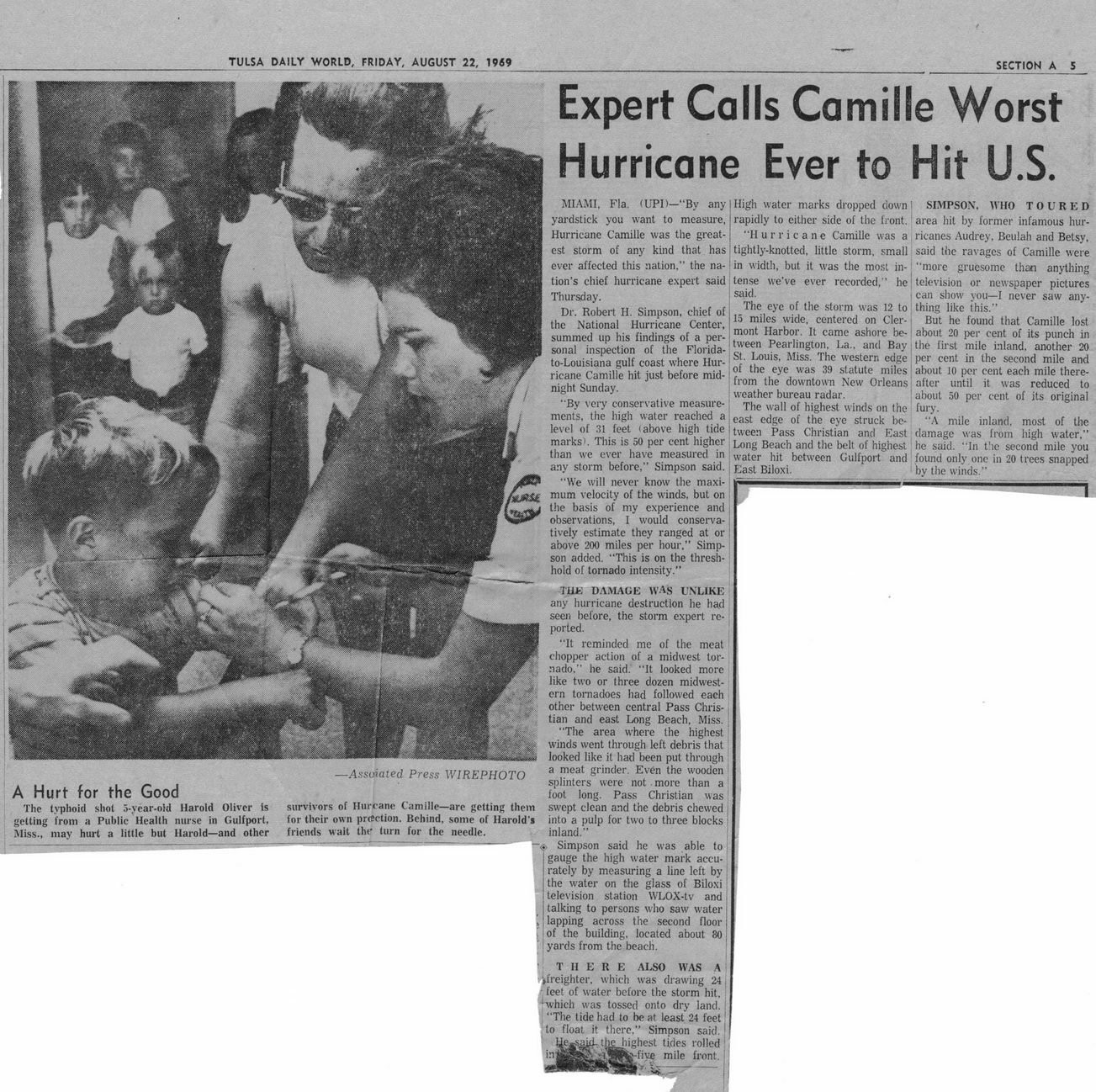This text was obtained via automated optical character recognition.
It has not been edited and may therefore contain several errors.
?Assoiated Press WIREPHOTO A Hurt for the Good The tvphoid shot 5-vear-old Harold Oliver is getting from a Public Health nurse in Gulfport, Miss., may hurt a little but Harold?and other survivors of Hurcane Camille?are getting them for their own prrtction. Behind, some of Harold '? friends wait tht' turn for the needle. SECTION A 5 Expert Calls Camille Worst Hurricane Ever to Hit U.S. MIAMI, Fla. (UPI)??By any yardstick you want to measure, Hurricane Camille was the greatest storm of any kind that has ever affected this nation,? the nation's chief hurricane expert said Thursday. Dr. Robert H. Simpson, chief of the National Hurricane Center, summed up his findings of a personal inspection of the Florida-to-Louisiana gulf coast where Hurricane Camille hit just before midnight Sunday. "By very conservative measurements, the high water reached a level of 31 feet (above high tide marks*. This is 50 per cent higher than we ever have measured in any storm before,? Simpson said, ?We will never know the maximum velocity of the winds, but on the basis of my experience and observations, I would conservatively estimate they ranged at or above 200 miles per hour,? Simpson added. "This is on the thresh-hold of tornado intensity.? THE DAMAGE YV'AS UNLIKE any hurricane destruction he had seen before, the storm expert reported. ?It reminded me of the meat chopper action of a midwest tornado,? he said. ?It looked more like two or three dozen midwest-ern tornadoes had followed each other between central Pass Christian and east Long Beach, Miss. ?The area where the highest winds went through left debris that looked like it had been put through a meat grinder. Even the wooden splinters were not more than a foot long. Pass Christian was swept clean and the debris chewed into a pulp for two to three blocks inland.? .. Simpson said he was able to gauge the high water mark accurately by measuring a line left by the water on the glass of Biloxi television station WLOX-tv and talking to persons who saw water lapping across the second floor of the building, located about 80 yards from the beach. High water marks dropped down! rapidly to either side of the front. ?II urricane Camille was a tightly-knotted, little storm, small in width, but it was the most intense we've ever recorded,? he said. The eye of the storm was 12 to 15 miles wide, centered on Clermont Harbor. It came ashore between Pearlington, La., and Bay St. Louis, Miss. The western edge of the eye was 39 statute miles from the downtown New Orleans weather bureau radar. The wall of highest winds on the east edge of the eye struck between Pass Christian and East Long Beach and the belt of highest water hit between Gulfport and East Biloxi. SIMPSOV, WHO TOURED area hit by former infamous hurricanes Audrey. Beulah and Betsy, said the ravages of Camille were ?more gruesome than anything television or newspaper pictures can show you?I never saw anything like this.? But he found that Camille lost about 20 per cent of its punch in the first mile inland, another 20 per cent in the second mile and about 10 per cent each mile thereafter until it was reduced to about 50 per cent of its original fury. ?A mile inland, most of the damage was from high water,? he said. ?In the second mile you found only one in 20 trees snapped by the winds.? ' THERE ALSO WAS A '^freighter, which was drawing 24 I feet of water before the storm hit. ?which was tossed onto dry land. ( ?The tide had to be at least 24 feet j to float it there,? Simpson said. 1 highest ti,des rolled 1 |?five mile front. -----------; I

Kergosien 014